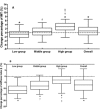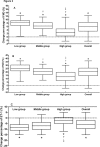Reducing Visit-To-Visit Variability in Systolic Blood Pressure for Improving the Progression of Carotid Atherosclerosis and Endothelial Dysfunction in Patients with Hypertension Management
- PMID: 26110143
- PMCID: PMC4475591
Reducing Visit-To-Visit Variability in Systolic Blood Pressure for Improving the Progression of Carotid Atherosclerosis and Endothelial Dysfunction in Patients with Hypertension Management
Abstract
Background: Visit-to-visit variability (VVV) in blood pressure (BP) creates challenges to hypertension control and was independent associated with increased all-cause mortality in hypertensive patients. The major goal of the present study was to investigate the association of VVV in systolic (S)BP with progression of carotid atherosclerosis and en-dothelial dysfunction in on-treated hypertensive patients.
Methods: Overall, 356 hypertensive patients were enrolled and completed the trial. Clinic BP was measured at baseline and at 3 monthly thereafter. Carotid artery ultrasound and endothelial function were evaluated at baseline and annually follow-up visit. VVV in BP was assessed by standard deviation (SD) and coefficient of variation (CV) of serial follow-up BP measurements. The patients were divided into low, middle, and high group by tertile of SD in SBP.
Results: Decrease percentage of maximum intima-media thickness (IMT) and stiffness index β and increase percentage of brachial flow-mediated dilation (FMD) and nitric oxide (NO) in lower groups were significant greater than in higher groups (P < 0.05). Change percentage of stiffness index β and endothelin-1 positively, and change percentage of FMD and NO negatively correlated with SD, CV, maximum, and delta of SBP (P < 0.05). SD and CV of SBP were risk factors for change percentage of IMT, stiffness index β, FMD, NO, and endothelin-1 independently of other influential factors, such as age, and mean SBP.
Conclusion: Excessive VVV in SBP maybe increase carotid atherosclerosis and impair endothelial function in on-treated hypertensive patients. Reducing VVV in SBP is benefit for patients with hypertension management.
Keywords: Antihypertension; Atherosclerosis; Blood pressure variability; Endothelial dysfunction.
Figures



References
-
- Mancia G, Fagard R, Narkiewicz K, Redon J et al. (2013). 2013 ESH/ESC Guidelines for the management of arterial hypertension: The Task Force for themanagement of arterial hypertension of the European Society of Hypertension (ESH) and of the European Society of Cardiology (ESC). Eur Heart J, 34: 2159–2219. - PubMed
-
- Chobanian AV, Bakris GL, Black HR et al. (2003). The Seventh Report of the Joint National Committee on Prevention, Detection, Evaluation, and Treatment of High Blood Pressure: the JNC 7 report. JAMA, 289: 2560–2572. - PubMed
-
- Rothwell PM, Howard SC, Dolan E, O’Brien e, Dobson JE, Dahlöf B, Sever PS, Poulter NR (2010). Prognostic significance of visit-to-visit variability, maximum systolic blood pressure, and episodic hypertension. Lancet, 375: 895–905. - PubMed
-
- Muntner P, Levitan EB (2013). Visit-to-visit variability of blood pressure: current knowledge and future research directions. Blood Press Monit, 18: 232–238. - PubMed
-
- Rossignol P, Kessler M, Zannad F (2013). Visit-to-visit blood pressure variability and risk for progression of cardiovascular and renal diseased. Curr Opin Nephrol Hypertens, 22: 59–64. - PubMed
LinkOut - more resources
Full Text Sources
Research Materials
